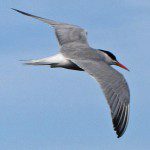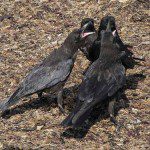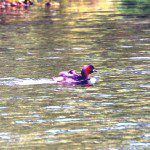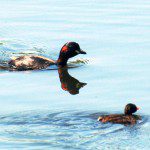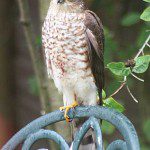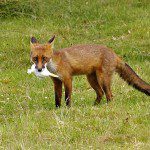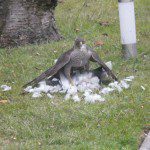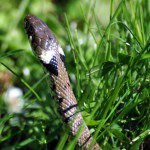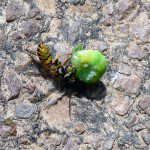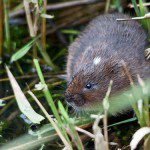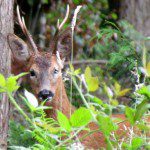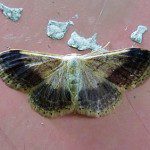Axe Estuary Birds birding newsletter is published with permission, and sincere thanks to the team behind it. As always, we have reproduced it as faithfully as possible for the web.
Axe Estuary Birds No 163 August 31st 2011
The Birds
Ian Waite counted no less than 36 Little Egrets at Colyford Common on 15th August, and one Sandwich Tern. And then later at the FSC at Black Hole Marsh saw a young Cuckoo feeding up on caterpillars ready for the long journey south. It seems along time ago that we had a Cuckoo actually on one of the reserves.
John Stentiford was on Beer Head on 21st, and says he saw many more Wheatears there than he would expect at this time of year. Early migration? Hard winter ahead?
Peter Butler took this photo of a Sparrow Hawk in his Seaton Garden.
The Oyster Catcher chick at BHM seems to be flourishing and has been assiduously watched by Sue Smith, who says the parents have been most attentive. As you can see, the chick is now well grown, but still has pale legs.
On the same day Sue took a lovely photo of two Little Egrets landing (if that’s the right word for a descent onto water!)
Stop Press! Sue has just sent me a photograph of the Cuckoo !
Wet and Wild Weekend
On Sunday 21st August, three generations of the Anderson family spent a wonderful morning at this event.
We started off watching the bird ringing which none of us had seen before, seeing Blue Tits, Robins and Sedge Warblers. The latter were wonderful to see close up and see just how tiny they are – you do not get the idea of size through binoculars or a scope. This was seen whilst also enjoying bacon rolls and coffee – great!
After this the girls made fluffy animals from wool then decorating them from materials provided. Following on from this they joined the clay modeling table and one made a hedgehog and the other a swallow. Some of the group then went into the field with large nets to sweep through the grass looking to find insects etc.
I went with the two granddaughters to the tiny stream, where armed with nets, they caught various “little creatures” from the river bed. These included mayfly larvae and a tiny eel amongst other things. A very knowledgeable gentleman was eagerly telling us all about our finds. In between all this the ITV crew arrived and, with our permission, televised us. We were able to watch ourselves on the local news later in the day.
I had to reluctantly drag the children away to go home for lunch, but others including a family on holiday were staying to make bird boxes.
The East Devon rangers and volunteers put on a wonderful event over three days and should be highly praised for all they are doing to generate knowledge, interest and enthusiasm in this area. Not only did they teach the children, but parents and grandparents too!! Many thanks to all concerned.
Moira Anderson and family.
The Trivia
From Peter Vernon “ I have attached a few images of another favourite moth I am regularly catching at the moment in my moth trap. It is a Canary-shouldered Thorn and yes it is sitting on my hand!
I have had two firsts for the garden in the last couple of days, in 13 years here I have never seen either before. The first was a Brown Argus butterfly which was nectaring on our marjoram in our garden and I also saw one in our little meadow.

The second which I caught last night in the moth trap was an Old Lady Mormo maura moth, although dowdy colouring it was an impressive beast with a wingspan of around 60mm.”

John Stentiford reports seeing seven Dolphins in the sea off Beer Head on Sunday 21st. It was a still day, and he had great views’
Mike Hughes a wildlife artist living in East Devon, I also do some design work for EDDC Including work on the Bird Reports.
He is having an exhibition of his work in early September in your next newsletter. Details are as follows.
Mike Hughes – Wildlife Art Exhibition, The Gallery, Hind Street, Ottery St Mary, 3-17 September
Gallery open Tuesday to Saturday
Colyford Common Snippets
The early part of the week was mostly cloudy with occasional light rain or drizzle and ‘useful’ rain overnight on 17th-18th. The ‘Wet and Wild Weekend’ was changeable with rain during the morning of the Saturday but Sunday was warm and sunny.
The 49 Canada Geese were seen on the scrape on 15th, and a single Teal was there on 16th and four juvenile Shelduck on the 18th.
Up to 25 Little Egrets were on the scrape on 15th and a maximum count of seven Grey Heron were there on 20th.
Two Kestrels were seen on the reserve on 16th.The scrape continues to provide excellent sightings of waders: a max. of eight Ringed Plovers on 18th, three Lapwings on 16th and a single Knot on 18th and 20th, six Dunlin on 15th , a Black-tailed Godwit on the same day, 53 Curlew on 18th and 51 on 20th, a single Whimbrel was in the area on 20th and 21st, three Sandpiper species were noted – a single Common on 20th and 21st, 3 Green on 19th and a Wood Sandpiper on 16th and finally, a maximum of three Greenshank were present on 16th – a total of 11 species.
The 23 birds caught during the ringing demonstration on 21st at the Wet and Wild Weekend included seven Sedge Warblers, one of which was a ‘control’ (i.e. ringed elsewhere), one Reed Warbler and three Chiffchaffs. During the week a Willow Warbler was noted on the reserve on 15th and one observer saw two Whitethroats on the tramway on 18th.
A record of eight Grey Wagtail noted in the log on 21st as being on the scrape is unusually high for the reserve which rarely boasts more than a single bird; such a number is high even for Devon and one cannot help wondering if these were in fact juvenile Pied Wagtails.
News from Holyford Woods
What a tremendous difference to be back in our green Woods again after the bitterly cold winter experience of Botswana at this time of the year. I was privileged to see three Leopards, one with a cub up a tree devouring the kill, and two Cheetahs twice, not to mention the other animals and wonderful birds, especially waders, in the amazing wet environment of the Okavango Delta. There is even more water there than usual and some tracks were impassable.
At this time of year our Woods are very quiet. Little bird activity though I have heard bird calls such as twoGreen Wood Pecker, Greater Spotted Woodpecker,Wrens still defending territory, Nuthatch, Corvids including the Ravens which have returned, one young Buzzard, and the Robins. The brambles are soaking wet so there have been no deer feeding there. They prefer to be in the conifers or the open grassy places. The Wasps nest has gone now, and today Paco located a Bees nest dug out by a Badger. On the path to my seat I nearly crushed two thumbnail sized Toads, a long way from the stream and pools in the valley. I have picked plenty of blackberries – why do people gather theirs from polluted roadsides when there they are, untainted in beautiful surroundings? On a lovely warm morning EDDC CountrysideTeam held a very successful morning event in the Woods, entitled Use Your Senses. This was well attended by 7 adults with 11 enthusiastic children of varying ages. Lovely to see them and share their enjoyment.
Jean Kreiseler
Sorry this newsletter is a bit sparce – my eyes are still not right. Many thanks to all of you who have sent encouraging messages.
This twice-monthly email newsletter is freely available to anyone who would like it, as is a periodic one about the activities of the East Devon Local Group of the Devon Wildlife Trust. Just send me an email with Axe Estuary Birds and/or East Devon DWT in the subject line. Also, for those without a computer, I will send a copy by post if you would like to send me some stamps.
Thanks to those who keep me informed. Please continue to tell me of any unusual, interesting or amusing sightings, and what is about locally, and send any photos you would like to share.
Jean, Bob and David. (and many others!) davidwalters@eclipse.co.uk. tel. 01297 552616 Mobile 0779 1541 744.















